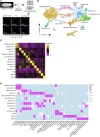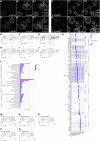Single-cell transcriptomics identifies new blood cell populations in Drosophila released at the onset of metamorphosis
- PMID: 37681301
- PMCID: PMC10560556
- DOI: 10.1242/dev.201767
Single-cell transcriptomics identifies new blood cell populations in Drosophila released at the onset of metamorphosis
Abstract
Drosophila blood cells called hemocytes form an efficient barrier against infections and tissue damage. During metamorphosis, hemocytes undergo tremendous changes in their shape and behavior, preparing them for tissue clearance. Yet, the diversity and functional plasticity of pupal blood cells have not been explored. Here, we combine single-cell transcriptomics and high-resolution microscopy to dissect the heterogeneity and plasticity of pupal hemocytes. We identified undifferentiated and specified hemocytes with different molecular signatures associated with distinct functions such as antimicrobial, antifungal immune defense, cell adhesion or secretion. Strikingly, we identified a highly migratory and immune-responsive pupal cell population expressing typical markers of the posterior signaling center (PSC), which is known to be an important niche in the larval lymph gland. PSC-like cells become restricted to the abdominal segments and are morphologically very distinct from typical Hemolectin (Hml)-positive plasmatocytes. G-TRACE lineage experiments further suggest that PSC-like cells can transdifferentiate to lamellocytes triggered by parasitoid wasp infestation. In summary, we present the first molecular description of pupal Drosophila blood cells, providing insights into blood cell functional diversification and plasticity during pupal metamorphosis.
Keywords: Drosophila; Blood; Hemocytes; Lamellocytes; Migration; PSC; Plasmatocytes; Progenitor; scRNA-seq analysis.
© 2023. Published by The Company of Biologists Ltd.
Conflict of interest statement
Competing interests The authors declare no competing or financial interests.
Figures







References
-
- Anderl, I., Vesala, L., Ihalainen, T. O., Vanha-Aho, L.-M., Andó, I., Rämet, M. and Hultmark, D. (2016). Transdifferentiation and proliferation in two distinct hemocyte lineages in Drosophila melanogaster larvae after Wasp infection. PLoS Pathog. 12, e1005746. 10.1371/journal.ppat.1005746 - DOI - PMC - PubMed
-
- Andersen, D. S., Colombani, J., Palmerini, V., Chakrabandhu, K., Boone, E., Röthlisberger, M., Toggweiler, J., Basler, K., Mapelli, M., Hueber, A.-O.et al. (2015). The Drosophila TNF receptor Grindelwald couples loss of cell polarity and neoplastic growth. Nature 522, 482-486. e1005746. 10.1038/nature14298 - DOI - PubMed
Publication types
MeSH terms
Substances
LinkOut - more resources
Full Text Sources
Molecular Biology Databases

